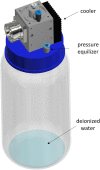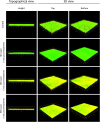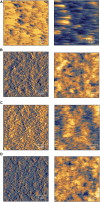Plasma-Treated Water Affects Listeria monocytogenes Vitality and Biofilm Structure
- PMID: 33995311
- PMCID: PMC8113633
- DOI: 10.3389/fmicb.2021.652481
Plasma-Treated Water Affects Listeria monocytogenes Vitality and Biofilm Structure
Abstract
Background: Plasma-generated compounds (PGCs) such as plasma-processed air (PPA) or plasma-treated water (PTW) offer an increasingly important alternative for the control of microorganisms in hard-to-reach areas found in several industrial applications including the food industry. To this end, we studied the antimicrobial capacity of PTW on the vitality and biofilm formation of Listeria monocytogenes, a common foodborne pathogen. Results: Using a microwave plasma (MidiPLexc), 10 ml of deionized water was treated for 100, 300, and 900 s (pre-treatment time), after which the bacterial biofilm was exposed to the PTW for 1, 3, and 5 min (post-treatment time) for each pre-treatment time, separately. Colony-forming units (CFU) were significantly reduced by 4.7 log10 ± 0.29 log10, as well as the metabolic activity decreased by 47.9 ± 9.47% and the cell vitality by 69.5 ± 2.1%, compared to the control biofilms. LIVE/DEAD staining and fluorescence microscopy showed a positive correlation between treatment and incubation times, as well as reduction in vitality. Atomic force microscopy (AFM) indicated changes in the structure quality of the bacterial biofilm. Conclusion: These results indicate a promising antimicrobial impact of plasma-treated water on Listeria monocytogenes, which may lead to more targeted applications of plasma decontamination in the food industry in the future.
Keywords: MidiPLexc; PTW; antimicrobial; cold plasma; food production industry; sustainability; viability.
Copyright © 2021 Handorf, Pauker, Weihe, Schäfer, Freund, Schnabel, Bekeschus, Riedel and Ehlbeck.
Conflict of interest statement
The authors declare that the research was conducted in the absence of any commercial or financial relationships that could be construed as a potential conflict of interest.
Figures









Similar articles
-
Plasma-Treated Air and Water-Assessment of Synergistic Antimicrobial Effects for Sanitation of Food Processing Surfaces and Environment.Foods. 2019 Feb 2;8(2):55. doi: 10.3390/foods8020055. Foods. 2019. PMID: 30717375 Free PMC article.
-
Effectiveness of phages in the decontamination of Listeria monocytogenes adhered to clean stainless steel, stainless steel coated with fish protein, and as a biofilm.J Ind Microbiol Biotechnol. 2013 Oct;40(10):1105-16. doi: 10.1007/s10295-013-1313-3. Epub 2013 Aug 2. J Ind Microbiol Biotechnol. 2013. PMID: 23907252
-
Disrupting Irreversible Bacterial Adhesion and Biofilm Formation with an Engineered Enzyme.Appl Environ Microbiol. 2021 Jun 11;87(13):e0026521. doi: 10.1128/AEM.00265-21. Epub 2021 Jun 11. Appl Environ Microbiol. 2021. PMID: 33893112 Free PMC article.
-
Molecular biology of surface colonization by Listeria monocytogenes: an additional facet of an opportunistic Gram-positive foodborne pathogen.Environ Microbiol. 2011 Apr;13(4):835-50. doi: 10.1111/j.1462-2920.2010.02378.x. Epub 2010 Nov 18. Environ Microbiol. 2011. PMID: 21087384 Review.
-
Lessons from the organization of a proficiency testing program in food microbiology by interlaboratory comparison: analytical methods in use, impact of methods on bacterial counts and measurement uncertainty of bacterial counts.Food Microbiol. 2006 Feb;23(1):1-38. doi: 10.1016/j.fm.2005.01.010. Food Microbiol. 2006. PMID: 16942983 Review.
Cited by
-
Deep Impact: Shifts of Native Cultivable Microbial Communities on Fresh Lettuce after Treatment with Plasma-Treated Water.Foods. 2024 Jan 16;13(2):282. doi: 10.3390/foods13020282. Foods. 2024. PMID: 38254583 Free PMC article.
-
Flow cytometry study of Escherichia coli treated with plasma-activated water: confirming the absence of the viable but non-culturable state in bacteria.Front Microbiol. 2025 Jun 4;16:1592471. doi: 10.3389/fmicb.2025.1592471. eCollection 2025. Front Microbiol. 2025. PMID: 40535012 Free PMC article.
-
Influence of plasma-treated air on surface microbial communities on freshly harvested lettuce.Curr Res Food Sci. 2023 Nov 30;7:100649. doi: 10.1016/j.crfs.2023.100649. eCollection 2023. Curr Res Food Sci. 2023. PMID: 38115898 Free PMC article.
-
Antimicrobial mechanism of in-situ plasma activated water treatment of pathogenic Escherichia coli and Staphylococcus aureus biofilms.Biofilm. 2025 Jul 7;10:100303. doi: 10.1016/j.bioflm.2025.100303. eCollection 2025 Dec. Biofilm. 2025. PMID: 40703961 Free PMC article.
-
Comparison of the efficacy of physical and chemical strategies for the inactivation of biofilm cells of foodborne pathogens.Food Sci Biotechnol. 2023 May 1;32(12):1679-1702. doi: 10.1007/s10068-023-01312-2. eCollection 2023 Oct. Food Sci Biotechnol. 2023. PMID: 37780592 Free PMC article. Review.
References
-
- Allison D. G. (2003). The biofilm matrix. Biofouling 19 139–150. - PubMed
-
- Andrasch M., Stachowiak J., Schlüter O., Schnabel U., Ehlbeck J. (2017). Scale-up to pilot plant dimensions of plasma processed water generation for fresh-cut lettuce treatment. Food Pack. Shelf Life 14 40–45.
-
- Arslan S., Baytur S. (2019). Prevalence and antimicrobial resistance of Listeria species and subtyping and virulence factors of Listeria monocytogenes from retail meat. J. Food Saf. 39:e12578.
-
- Baeva M., Bösel A., Ehlbeck J., Loffhagen D. (2012). Modeling of microwave-induced plasma in argon at atmospheric pressure. Phys. Rev. E 85:056404. - PubMed
LinkOut - more resources
Full Text Sources
Other Literature Sources
Molecular Biology Databases
Miscellaneous

